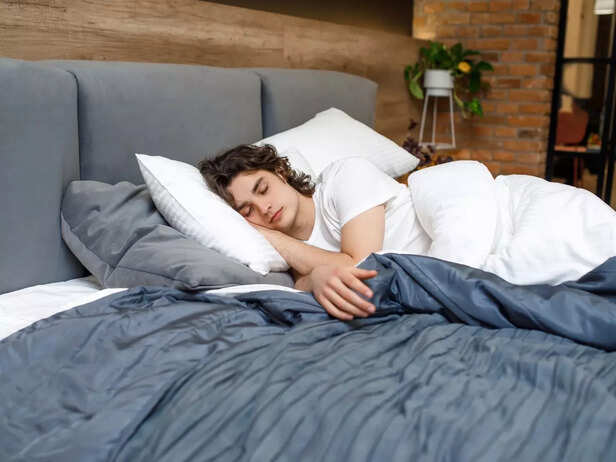When Did We Stop Sleeping on the Floor and Start Missing It?
Ritika | Sep 22, 2025, 19:08 IST
Man holding a pillow
( Image credit : Freepik )
Once a universal habit, sleeping on the floor has slipped out of modern lives, replaced by thick mattresses and designer beds. But many now look back with nostalgia, even curiosity, about what was lost. This article traces when and why the shift happened, what science and tradition say about it, and why people are revisiting the floor today.
For centuries, in every culture, humans slept on the floor. Reeds matting, woolen rugs, even bare earth covered with a sheet, were typical resting spots. But within only a few generations, the floor was replaced by the bed, elevated, padded, draped with technology that vowed ultimate comfort. The question remains, however: when did humanity swap simplicity for softness, and why do some now yearn for what was lost?

Floor-sleeping was not unusual. It was the norm. Woven mats of grass or bamboo were spread out at night and stored away in the morning in India. Tatami mats and futons in Japan were also intended to be spread out on the floor, to be folded up tidily by day. Nomads of Central Asia and the Middle East slept on rugs or hides spread on packed earth as well.
Sleeping low brought humans nearer to the natural world, nearer to the ground. It controlled body temperatures in warm climates, provided firm support, and maintained area's multi-purpose. A daytime living room was transformed into a sleeping place at night. The concept of elaborate bed frames or luxurious mattresses was not global decadence but an exception, usually reserved for nobility and the affluent. Most people had the earth itself, softened somewhat by matting or fabric, as where sleep occurred.

It came gradually but inexorably. Industrialization and changes in urban housing had something to do with it. As societies became richer and towns became dense, raised beds were sold as an emblem of elegance and cleanliness, keeping sleepers safe from dust, cold floors, and bugs. The development of metal spring mattresses during the 19th century brought a revolution: sleep was now packaged as an industry.
By the 20th century, advertisements didn't merely sell a product; it sold the concept that good sleep entailed a thick and soft mattress. Richly illustrated catalogues presented lavish beds as symbols of modern life, while floor sleeping was tinged with poverty, deficiency, or backward tradition. Folks started aspiring upward, literally. Increased incomes provided more households with the ability to purchase the comfort and status attainder of "real beds." In a generation or two, floor sleeping had nearly vanished from urban dwellings.

Surprisingly, as beds increased in height and mattresses in thickness, back pain, slouching, and sleeping fitfully also increased. Researchers note that the firmness of the floor provides better spinal alignment than a sagging mattress. Societies that retained floor sleeping habits frequently had fewer orthopedic complaints than societies that relied totally on spring or foam mattresses.
Certainly, floor sleeping is not always comfortable. For seniors, joint stress and struggle to rise can be problematic. But younger generations, especially in yoga or minimalism communities, have been reviving the advantages. Harder surface, lower body temperature, and even psychological serenity of streamlining one's sleeping arrangement have come into view. Physicians are still divided, what aids one set of shoulders might agitate another. But the nostalgia and interest in the practice demonstrate that it continues to resonate in the collective consciousness.

Go into conversations nowadays, and you hear someone say, "I slept on the floor at my grandmother's place, and it was the best night's sleep I ever had." Memories of lying on cold stone floors on hot summer nights, or curled up on a mat during family gatherings, color floor sleeping as a lost luxury.
Minimalist trends, city yoga retreats, and even sleep studies have compelled individuals to give it another go. Internet forums are full of testimonials: some rave about it, finding freedom, while others quit after a week of aching hips. Nevertheless, the truth is out there; floor sleeping is no longer taboo. It has become both a throwback yearning and an experiment in lifestyle. In some sense, skipping the floor indicates something bigger: contemporary existence, with its comforts, tends to lay on us aches that ancient, less complicated customs had wisely escaped.
The chronology of abandoning the floor is not defined by an instant but by a drift. The advance of industry, evolving housing fashions, increased incomes, and insistent marketing raised beds from choice to necessity. But the recent uptick in interest indicates that comfort is not a monolith. Maybe the yearning for sleeping on the floor isn't about posture or heat. It's about reaching back and being connected to something raw, plain, and earthy in a culture of excess. The question isn't when we lost it, it's whether some of us will start again.
Explore the latest trends and tips in Health & Fitness, Spiritual, Travel, Life Hacks, Trending, Fashion & Beauty, and Relationships at Times Life!
1. Ancient Roots and Everyday Practices

Woman sleeping on bed
( Image credit : Freepik )
Floor-sleeping was not unusual. It was the norm. Woven mats of grass or bamboo were spread out at night and stored away in the morning in India. Tatami mats and futons in Japan were also intended to be spread out on the floor, to be folded up tidily by day. Nomads of Central Asia and the Middle East slept on rugs or hides spread on packed earth as well.
Sleeping low brought humans nearer to the natural world, nearer to the ground. It controlled body temperatures in warm climates, provided firm support, and maintained area's multi-purpose. A daytime living room was transformed into a sleeping place at night. The concept of elaborate bed frames or luxurious mattresses was not global decadence but an exception, usually reserved for nobility and the affluent. Most people had the earth itself, softened somewhat by matting or fabric, as where sleep occurred.
2. The Emergence of Beds and the Mattress Industry

Sleeping woman
( Image credit : Freepik )
It came gradually but inexorably. Industrialization and changes in urban housing had something to do with it. As societies became richer and towns became dense, raised beds were sold as an emblem of elegance and cleanliness, keeping sleepers safe from dust, cold floors, and bugs. The development of metal spring mattresses during the 19th century brought a revolution: sleep was now packaged as an industry.
By the 20th century, advertisements didn't merely sell a product; it sold the concept that good sleep entailed a thick and soft mattress. Richly illustrated catalogues presented lavish beds as symbols of modern life, while floor sleeping was tinged with poverty, deficiency, or backward tradition. Folks started aspiring upward, literally. Increased incomes provided more households with the ability to purchase the comfort and status attainder of "real beds." In a generation or two, floor sleeping had nearly vanished from urban dwellings.
3. Science and the Forgotten Benefits

Woman lying on ground
( Image credit : Pixabay )
Surprisingly, as beds increased in height and mattresses in thickness, back pain, slouching, and sleeping fitfully also increased. Researchers note that the firmness of the floor provides better spinal alignment than a sagging mattress. Societies that retained floor sleeping habits frequently had fewer orthopedic complaints than societies that relied totally on spring or foam mattresses.
Certainly, floor sleeping is not always comfortable. For seniors, joint stress and struggle to rise can be problematic. But younger generations, especially in yoga or minimalism communities, have been reviving the advantages. Harder surface, lower body temperature, and even psychological serenity of streamlining one's sleeping arrangement have come into view. Physicians are still divided, what aids one set of shoulders might agitate another. But the nostalgia and interest in the practice demonstrate that it continues to resonate in the collective consciousness.
4. Nostalgia and the Quiet Return

Woman
( Image credit : Freepik )
Go into conversations nowadays, and you hear someone say, "I slept on the floor at my grandmother's place, and it was the best night's sleep I ever had." Memories of lying on cold stone floors on hot summer nights, or curled up on a mat during family gatherings, color floor sleeping as a lost luxury.
Minimalist trends, city yoga retreats, and even sleep studies have compelled individuals to give it another go. Internet forums are full of testimonials: some rave about it, finding freedom, while others quit after a week of aching hips. Nevertheless, the truth is out there; floor sleeping is no longer taboo. It has become both a throwback yearning and an experiment in lifestyle. In some sense, skipping the floor indicates something bigger: contemporary existence, with its comforts, tends to lay on us aches that ancient, less complicated customs had wisely escaped.
Wrapping Up
Explore the latest trends and tips in Health & Fitness, Spiritual, Travel, Life Hacks, Trending, Fashion & Beauty, and Relationships at Times Life!
